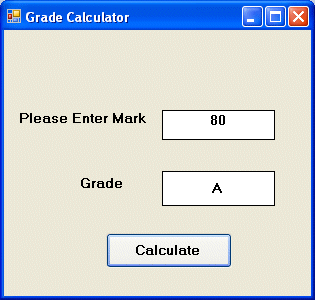In the previous Lesson, we have learned the If...Then...Else control structure. In this Lesson, you will learn another way to control the program flow in Visual Basic 2010, that is, the Select Case control structure. Select Case control structure is slightly different from the If....Else...Then control structure. The difference is that the Select Case control structure typically only make a decision on one expression. On the other hand, the If ...Then...Else statement control structure may evaluate only one expression, or it may also compute entirely different dimensions. Select Case is preferred when there exist multiple conditions.
The syntax of the Select Case control structure is as follows:
Select Case test expression Case expression list 1 Block of statements Case expression list 2 Block of Statements . . Case Else Block of Statements End Select
The usage of Select Case is shown in the following examples
' Examination Grades Dim grade As String Private Sub Compute_Click( ) grade=txtgrade.Text Select Case grade Case "A" Label1.Text="High Distinction" Case "A-" Label1.Text="Distinction" Case "B" Label1.Text="Credit" Case "C" Label1.Text="Pass" Case Else Label1.Text="Fail" End Select End Sub
In this example, you can use the keyword Is together with the comparison operators.
Private Sub Button1_Click(ByVal sender As System.Object, ByVal e As System.EventArgs) Handles Button1.Click Dim mark As Single mark = mrk.Text Select Case mark Case Is >= 85 Label1.Text= "Excellence" Case Is >= 70 Label2.Text= "Good" Case Is >= 60 Label3.Text = "Above Average" Case Is >= 50 Label4.Text= "Average" Case Else Label5.Text = "Need to work harder" End Select End Sub
Example 10.2 can be rewritten as follows:
Private Sub Button1_Click(ByVal sender As System.Object, ByVal e As System.EventArgs) Handles Button1.Click 'Examination Marks Dim mark As Single mark = Textbox1.Text Select Case mark Case 0 to 49 Label1.Text = "Need to work harder" Case 50 to 59 Label1.Text = "Average" s Case 60 to 69 Label1.Text= "Above Average" Case 70 to 84 Label1.Text = "Good" Case 85 to 100 Label1.Text= "Excellence" Case Else Label1.Text= "Wrong entry, please reenter the mark" End Select End Sub
Grades in high school are usually presented with a single capital letter such as A, B, C, D or E. The grades can be computed as follow:
Private Sub Button1_Click(ByVal sender As System.Object, ByVal e As System.EventArgs) Handles Button1.Click 'Examination Marks Dim mark As Single mark = TextBox1.Text Select Case mark Case 0 To 49 Label1.Text = "E" Case 50 To 59 Label1.Text = "D" Case 60 To 69 Label1.Text = "C" Case 70 To 79 Label1.Text = "B" Case 80 To 100 Label1.Text = "A" Case Else Label1.Text = "Error, please reenter the mark" End Select End Sub
The output of Example 10.4

Copyright©2008 Dr.Liew Voon Kiong. All rights reserved |Contact|Privacy Policy